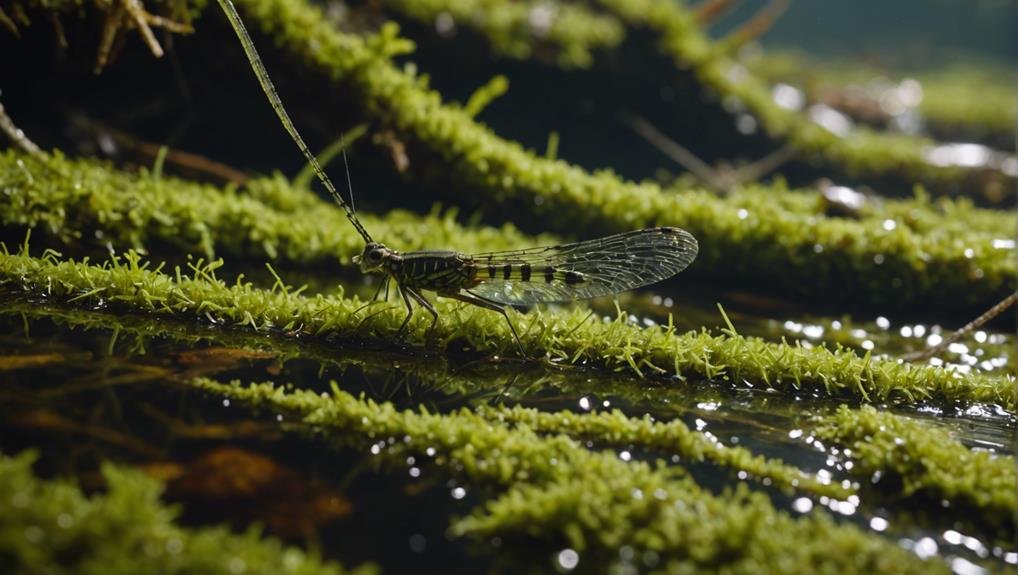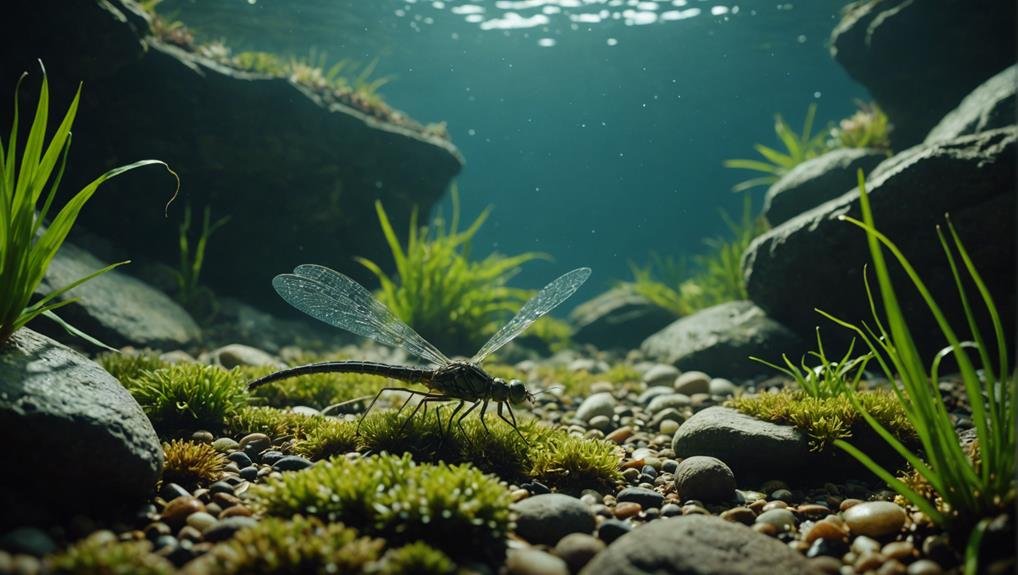Mayfly larvae are fascinating creatures found in freshwater environments like streams and rivers. These larvae, with their six legs ending in hooks and feathery gills along their abdomen, come in sizes ranging from 3 to 30 millimeters. They thrive in clean, well-oxygenated water, especially on substrates like gravel and decaying leaves. Their diet consists of decaying organic matter, algae, and weedy plants, and they use different feeding strategies such as grazing and filter feeding. Mayfly larvae are essential for ecosystems as they serve as both prey and indicators of water quality. Their life cycle, starting from egg to nymph and then to short-lived adult, provides crucial insights into freshwater habitats. Exploring these larvae further reveals even more intriguing details about their importance in the natural world.
Physical Characteristics
Mayfly larvae have six legs with single hooks at the end of each, along with two or three long tail-like appendages to help them move in water. These larvae typically range from 3 to 30 millimeters in length. One distinctive feature of their anatomy is the presence of feathery gills along the sides of their abdomen, crucial for respiration while underwater. As they progress through various growth stages, the larvae undergo significant changes. Starting off small and less developed, they gradually grow larger and sturdier before eventually maturing into adult mayflies. Their flat heads and smaller eyes, compared to adults, facilitate their ability to burrow and hide within the substrate of freshwater habitats where they live and thrive.
Habitat Preferences
Thriving in clean, well-oxygenated freshwater environments, mayfly larvae are commonly found in streams, rivers, and aerated ponds. These larvae have specific preferences for their microhabitat, often choosing areas with a continuous flow of water and high oxygen levels. They tend to inhabit substrates such as gravel, sand, or decaying leaves, which offer the necessary oxygen for their survival. This substrate preference also aids in predator avoidance and food acquisition. Despite their small size, some larger mayfly larvae exhibit predatory behavior, feeding on smaller aquatic organisms. Due to their sensitivity to water quality, mayfly larvae serve as excellent bioindicators, unable to thrive in polluted conditions. Understanding their habitat preferences is crucial for conservation efforts and the maintenance of healthy aquatic ecosystems.
Diet and Feeding Habits

Mayfly larvae have a diverse diet, feeding on decaying organic matter, algae, and weedy plants. Their omnivorous nature allows them to utilize a variety of nutrient sources. While most mayfly larvae are detritivores, some also exhibit predatory behavior by preying on smaller organisms.
These larvae employ different feeding strategies to obtain their food, including grazing, filter feeding, and shredding. Grazing involves scraping algae off rocks and submerged surfaces, while filter feeding utilizes their feathery gills to trap particles from the water. Shredding, on the other hand, involves breaking down larger pieces of organic matter.
Behavior and Interaction
Mayfly larvae display intriguing behaviors that highlight their adaptability and important role in aquatic ecosystems. They exhibit predatory behavior by preying on smaller invertebrates, showcasing their place in predator-prey dynamics. This behavior emphasizes their ecological significance as both predators and prey. When reproducing, larvae actively seek out suitable environments to ensure the survival of their offspring. Their interactions with various species, such as fish and amphibians, contribute to a balanced ecosystem. To evade predators, mayfly larvae often hide under rocks or substrate, demonstrating their survival tactics. The presence of these larvae in clean water bodies indicates a healthy ecosystem, underscoring their crucial role in environmental monitoring and ecological balance.
Life Cycle

Mayflies have a captivating life cycle that begins with a mesmerizing mating ritual above water bodies. During these rituals, male and female mayflies engage in intricate aerial dances before females lay eggs on the water's surface. These eggs then sink and attach to the substrate, initiating the mayflies' rapid life cycle which includes three main stages:
- Egg Stage: Eggs hatch into larvae, also known as nymphs.
- Nymph Stage: Nymphs reside underwater, feeding on detritus and algae.
- Adult Stage: Adults emerge, mate, lay eggs, and perish within a few days.
This swift life cycle plays a crucial role in the food chain by providing essential nourishment for various aquatic and terrestrial predators, such as fish, frogs, and birds.
Environmental Benefits
Mayfly larvae are crucial for maintaining a healthy ecosystem by supporting a diverse range of aquatic and terrestrial wildlife. These larvae serve as a key food source for various species, promoting wildlife diversity. They play a vital role in the food chain by providing essential nutrition for fish like trout and bass, which in turn sustains higher trophic levels such as birds and mammals. Additionally, their detritivorous behavior helps break down organic matter, contributing to overall pond health. By ensuring that fish have an ample food supply, mayfly larvae help enhance the stability and productivity of aquatic ecosystems, highlighting their significant environmental benefits.
Attracting Mayfly Larvae

To attract mayfly larvae to your pond, it is essential to maintain clean, well-oxygenated water with some gentle movement and a healthy substrate. Keeping the pond in top condition involves regularly checking the water quality and ensuring the presence of aquatic plants. These plants not only provide a suitable habitat but also help maintain oxygen levels in the water.
Here are some key tips to attract mayfly larvae:
- Regular Aeration: Use an aeration system to keep the water moving and oxygen levels high.
- Aquatic Plants: Introduce a variety of aquatic plants to create a thriving ecosystem.
- Balanced Fish Feeding: Ensure that fish are fed properly without overfeeding, which can harm water quality.
Conclusion
Mayfly larvae play a vital role in aquatic ecosystems, thanks to their unique features like feathery gills and tail-like appendages. These larvae thrive in clean, oxygen-rich waters, contributing to biodiversity and serving as a crucial food source for many species. By feeding on decaying matter and algae, they help maintain water quality, making them essential to the health of pond environments. Understanding the life cycle and behaviors of mayfly larvae can promote ecological balance and support a vibrant aquatic habitat. Attracting these fascinating creatures can enhance the intricate web of life that relies on them, creating a healthier ecosystem overall.

